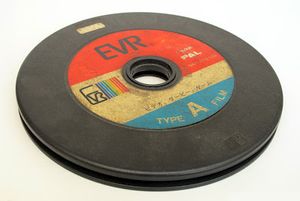| Site Notice |
|---|
|
We have a limited coverage policy. Please check our coverage page to see which articles are allowed. |
Difference between revisions of "EVR Race"
Torchickens (talk | contribs) (Created page with "{{Game infobox |title=EVR Race |jptitle= |jptrans= |boxart=EVR Race flyer.png |caption=Flyer |publisher=Nintendo |developer=Nintendo |console=Arcade |category={{{category}...") |
Torchickens (talk | contribs) (From "EVR RACE" page history, which became a redirect.) |
||
| Line 26: | Line 26: | ||
==Summary== | ==Summary== | ||
| − | EVR Race is a basic horse racing betting game. It was designed by [[Genyo Takeda]]. | + | EVR Race is a basic mechanical horse racing betting game. It was designed by [[Genyo Takeda]]. |
| + | |||
| + | This game uses EVR (Electronic Video Recording)[[File:Nintendo evr 20.JPG|thumb|The EVR tape used in the cabinet. It's labeled "Video Derby Game"]] technology. Unlike other Nintendo arcade games (''[[Donkey Kong]]'', ''[[Mario Bros.]]'', et cetera), it is not a video arcade game. There were 4 different types: EVR Race-2, 3, 4, and 5. Each type supported up to the number it was, so 2=2 players, 3=3 players,and so on. There were different models for each though. For example, EVR Race-3 had 2 different variations: one that supported a minimum of 1 and 2. 4 had 1, 2, and 3, and 5 had 1, 2, 3, and 4. It was Nintendo's first time incorporating video technology. | ||
{{stub}} | {{stub}} | ||
Revision as of 19:05, 23 March 2019
| EVR Race | ||||||||||||||
| ||||||||||||||
| ||||||||||||||
| ||||||||||||||
|
EVR Race is an arcade game by Nintendo. It is Nintendo's first standard arcade game, following on from the Laser Clay Shooting System.
Summary
EVR Race is a basic mechanical horse racing betting game. It was designed by Genyo Takeda.
This game uses EVR (Electronic Video Recording)
technology. Unlike other Nintendo arcade games (Donkey Kong, Mario Bros., et cetera), it is not a video arcade game. There were 4 different types: EVR Race-2, 3, 4, and 5. Each type supported up to the number it was, so 2=2 players, 3=3 players,and so on. There were different models for each though. For example, EVR Race-3 had 2 different variations: one that supported a minimum of 1 and 2. 4 had 1, 2, and 3, and 5 had 1, 2, 3, and 4. It was Nintendo's first time incorporating video technology.
| This article is a stub. You can help NintendoWiki by expanding it. |

